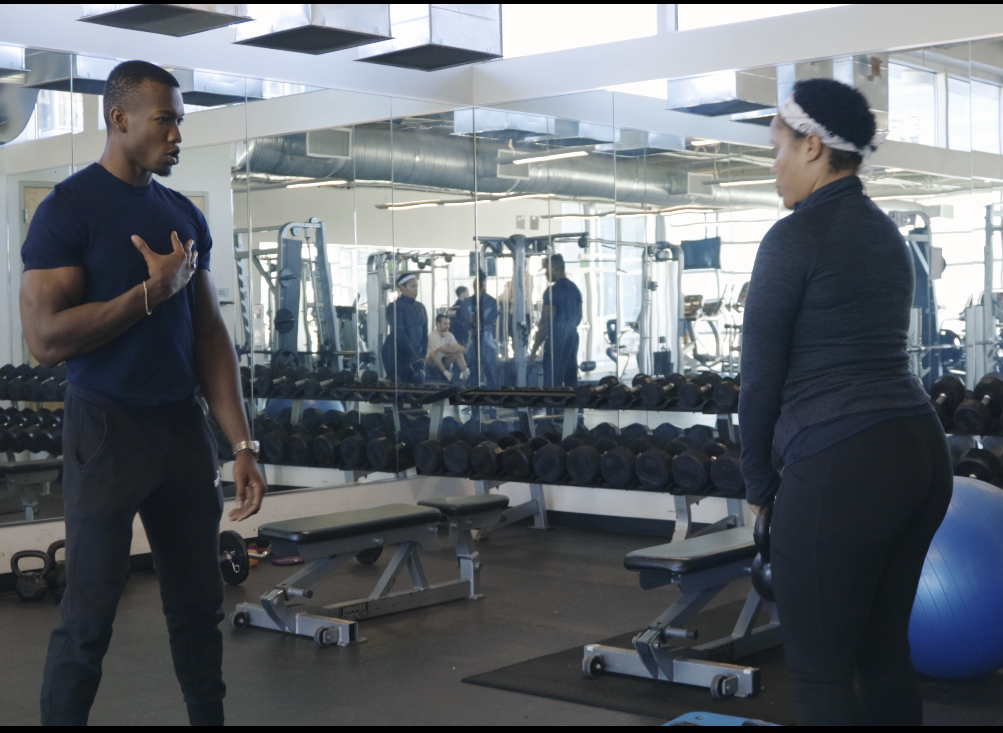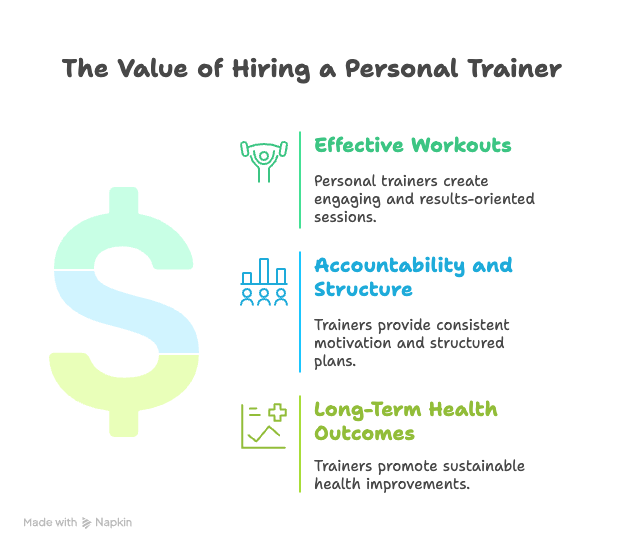
I. Introduction
Let’s get this out of the way: personal trainers aren’t just for Hollywood stars or gym junkies chasing six-packs. In fact, the modern personal trainer is a wellness strategist, a motivator-in-chief, and sometimes—even your unofficial therapist with a stopwatch.
Gone are the days of drill-sergeant stereotypes. Instead, today’s personal trainers are holistic health partners who help clients move better, feel stronger, and live fuller lives. They don’t just provide workouts—they create tailored routines and share lifestyle tips that actually stick.
Because of this shift, their support goes well beyond the gym floor. In this blog, we’ll pull back the curtain and dive into what personal trainers actually do—from designing personalized fitness plans to being your biggest cheerleader.
So, if you’ve ever wondered whether hiring a trainer is worth it, this might be the push you’ve been waiting for.
II. The Core of the Craft: Primary Responsibilities of a Personal Trainer
1. Initial Fitness Assessments
Before the sweat starts, strategy comes first. That’s why a good personal trainer begins by taking stock of your current fitness level, health history, and goals.
Whether you’re bouncing back from an injury, chasing a personal record, or simply looking to move pain-free again, the first step is always understanding where you’re starting from. These assessments—whether physical tests, movement screens, or lifestyle questionnaires—lay the groundwork for a safe and effective plan.
From the very beginning, the trainer’s goal is to meet you where you are.
2. Designing Personalized Workout Plans
Once the assessment is done, the real magic begins. Using that information, trainers design customized programs that align with your body, your abilities, and your ambitions—be it fat loss, muscle gain, increased mobility, or a mix of all three.
As your journey continues, your trainer doesn’t just stick to the original plan. Instead, they adapt it as needed, making changes based on your progress, preferences, or unexpected setbacks.
This ensures your workouts stay relevant, effective, and motivating over time.
3. Exercise Instruction and Supervision
Having the right plan is one thing—executing it properly is another. That’s where exercise instruction comes in. Personal trainers don’t just tell you what to do—they show you how to do it correctly.
From the angle of your squat to the rhythm of your breathing, they coach you through every movement. As a result, you move efficiently while reducing the risk of injury.
Think of them as your personal form police—minus the ticket book, but with plenty of encouragement.
4. Motivating and Mentoring
Even the most determined people hit motivational slumps. That’s when your personal trainer becomes your hype squad.
On days when the couch feels more inviting than the gym, they help you push through mental blocks, reframe setbacks, and celebrate small victories.
Rather than just counting reps, they shift your mindset and remind you why you started in the first place.
5. Progress Tracking and Reassessment
Of course, working hard is great—but working smart is even better. That’s why personal trainers track your progress with tools like body composition metrics, strength tests, and endurance checks.
These regular check-ins reveal what’s working and what might need a tweak. As a result, your program stays aligned with your goals—and you stay focused on your path forward.
It’s not just about doing more; it’s about doing what works best for you.
6. Offering Lifestyle and Nutrition Guidance
Fitness isn’t just built during your one-hour sessions—it’s shaped by your 23 other hours, too. That’s why many personal trainers offer practical advice on healthy eating, better sleep, stress management, and recovery habits.
While they won’t write detailed meal plans unless certified, they often provide tips that help support your training and avoid sabotaging it.
By focusing on the bigger picture, trainers help you build sustainable habits outside the gym.
7. Implementing Safety Protocols
Last but definitely not least: safety is always top priority. Trainers make sure you’re using equipment correctly, warm up and cool down properly, and stay within safe limits.
They’re often CPR or first aid certified, too, so if anything unexpected happens, they’re ready.
With these precautions in place, you can confidently push your limits knowing your well-being is being watched every step of the way.
III. Beyond the Workout: Additional Roles and Responsibilities

Leading Group Classes or Bootcamps
A great personal trainer does more than count reps. They often lead group classes—ranging from high-energy HIIT bootcamps to focused strength circuits. In this role, they manage energy, pacing, and a room full of fitness levels all at once. Therefore, group sessions become both effective and dynamic.
Keeping Up with Trends
The fitness world evolves fast. New training styles, mobility routines, and recovery tools emerge constantly. Because of this, personal trainers regularly seek certifications, attend workshops, and study research to keep your workouts fresh and evidence-based.
Building Rapport and Client Loyalty
This is where the magic happens. Trust, communication, and respect form the foundation of any successful trainer-client relationship. Great trainers remember your birthday, your goals, and when to challenge or encourage you. Ultimately, it’s not just about fitness—it’s about feeling seen.
Supporting Gym Operations or Selling Training Packages
In gyms, trainers often wear many hats. They may introduce new members to the facility, manage training schedules, or support marketing by offering trial sessions. Furthermore, many are responsible for selling training packages. The best ones, however, lead with value rather than pressure.

IV. Why It Matters: The Benefits of Hiring a Personal Trainer
Making Workouts Effective and Fun
Ever wandered around a gym unsure where to begin? A personal trainer eliminates guesswork and repetition, replacing them with variety and purpose. Not only do they design goal-driven workouts, but they also make them enjoyable—so you’re more likely to keep coming back.
Accountability and Structure
When someone is waiting for you at the gym, skipping isn’t as easy. That built-in accountability keeps you consistent. Add in a structured plan that adjusts with your progress, and suddenly, long-term success feels achievable.
Achieving Long-Term Health Outcomes
This goes beyond looking good. So with regular, guided exercise, you can improve heart health, posture, blood pressure, and even mental clarity. Trainers help you build strength and reduce injury risk, all while forming habits that last well into the future.
V. Where You’ll Find Them: Common Work Settings
Gyms and Fitness Studios
This is the classic setting. Gyms and boutique studios provide trainers with a steady flow of clients, a variety of equipment, and a professional environment. Here, they work with people of all ages and ability levels.
In-Home Training
Prefer privacy or convenience? Many personal trainers offer in-home sessions, bringing workouts and equipment to you. This option is great for those with busy schedules or a preference for solo environments.
Online Platforms
The rise of digital fitness has changed the game. Today, many trainers work through apps or video calls, delivering personalized training remotely. As a result, clients enjoy more flexibility and access—no matter where they live.
Solo Entrepreneurs vs. Corporate Trainers
Some trainers build their own brand and client base, while others work within corporate gyms. Each path offers unique benefits: entrepreneurship brings freedom, while corporate roles offer structure and support. Either way, their goal is to deliver value and results.
VI. The Must-Haves: Key Skills and Qualifications
Soft Skills: Communication, Empathy, and Motivational Flair
No one wants a coach who barks orders with zero empathy. The best trainers listen well, read emotional cues, and inspire without intimidation. In short, they know how to coach the whole person—not just the body.
Hard Skills: Fitness Knowledge and Professional Certifications
Expertise matters. The best trainers hold certifications from respected bodies like NASM, ACE, or NSCA. These credentials show a strong foundation in anatomy, exercise science, and program design. Because of this, clients can trust their guidance and results.
Ethics and Professionalism
Professionalism matters just as much as skill. Therefore, great trainers show up on time, respect client privacy, and maintain healthy boundaries. So at the end of the day, they’re committed not just to your gains—but to your growth as a person.
VII. Conclusion
Personal trainers are more than fitness guides—they’re partners in your journey toward a healthier, more energized life. From your first assessment to every drop of sweat that follows, they help you train with intention and live with more confidence and clarity.
They design the plan, coach the movements, adapt to real life, and celebrate your wins—big or small. Whether you’re chasing performance goals or simply want to feel better in your body, a trainer offers structure, motivation, and expertise that’s hard to replicate alone.
Thinking about working with one? Look for someone who listens, communicates clearly, holds solid certifications, and fits your vibe. After all, this is about more than fitness—it’s about unlocking your full potential, one session at a time.
SoFit Personal Training & Nutrition



